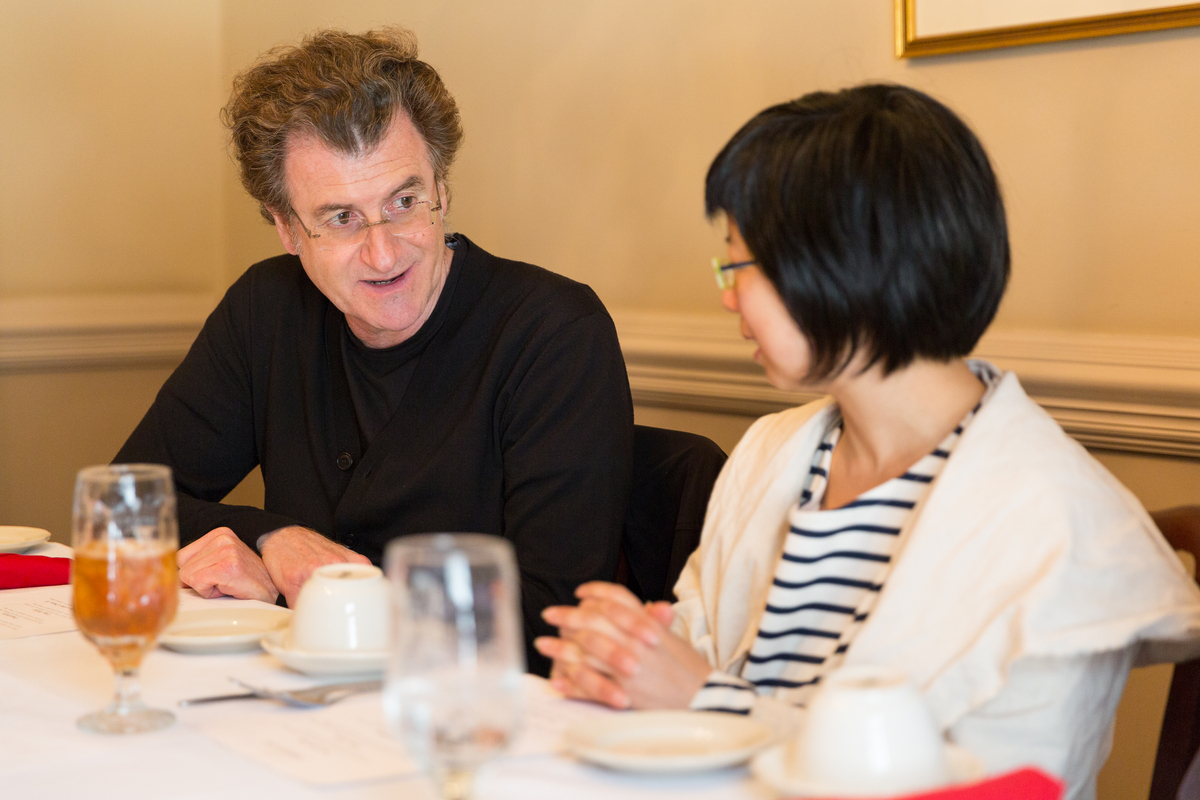Artist and journalist expound at humanities event

Artist Alfredo Jaar has produced more than 60 monumental public interventions that confront political violence, poverty, exploitation and imbalances of power.
Photos: Sarah Morton
MacArthur Award-winning artist Alfredo Jaar spoke to students, faculty and members of the public Friday as part of the Humanities Without Boundaries lecture series from the Center for the Humanities, a program that brings the university community into conversation with thinkers, artists, writers and activists of our time who are radically engaged with questions of what it means to be human.
“How do we make art when the world is in such a state? Every one of my projects attempts to answer that question,” said Jaar, whose talk came on the heels of a presentation the night before by war crimes journalist and Humanities Without Boundaries speaker Thierry Cruvellier.
“I’m interested in creating new models of thinking about the world — this is what I do as an artist. And this is what I think that art does best.”
Alfredo Jaar
Jaar, whose work is in the collections of some of the world’s most revered cultural institutions, has produced more than 60 monumental public interventions that confront political violence, poverty, exploitation and imbalances of power. He spent six years confronting the Rwandan genocide, built commissioned memorials to the disappeared in Chile and Argentina, and used an abandoned parliament building to make visible the 15,000 unacknowledged homeless of Montreal.
He recently completed a project in Japan commemorating the tragedy wrought by the 2011 tsunami and in 2014, at the Nasher Sculpture Center in Dallas, he radically redefined what it means for a museum to celebrate an anniversary.
“I quickly discovered how homogeneous the visitors of the museum were and I asked, ‘What is the most generous thing that the museum can do for those who do not come to the museum? Let’s celebrate the birthdays of those who don’t come to your museum, instead of your own.’” His work, while aesthetically exacting and precise, is very much concerned with real-world action. “I’m interested in creating new models of thinking about the world — this is what I do as an artist. And this is what I think that art does best.”

Most recently, journalist Thierry Cruvellier’s work has focused on the past 40 years of tumultuous history in Sierra Leone, and the possibility of bearing witness to radical forms of poverty.
Cruvellier has spent the last 16 years covering war crimes tribunals in Rwanda, Bosnia, Cambodia and Sierra Leone. He is the author of Master of Confessions: The Making of a Khmer Rouge Torturer and Court of Remorse: Inside the International Criminal Tribunal for Rwanda. Most recently, his work has focused on the past 40 years of tumultuous history in Sierra Leone, and the possibility of bearing witness to radical forms of poverty.
“For me, there is something that is pretty clear throughout my work, be it on Sierra Leone, Rwanda or Cambodia. My big interrogation is, ‘How do we behave in exceptional circumstances that no one of us want to be put in, where the choices you have to make are just impossible, and they may include the choice of dying, of being killed, for instance, in order not to kill?’”
On Friday morning the two spoke together in a public conversation moderated by Sara Guyer, professor of English and director of the Center for the Humanities, about the impossible task to which each of them has devoted his life’s work, of making real to others what they cannot and often do not want to see for themselves.
Jaar said of his experience in Rwanda, “My work became a series of strategies of representation, exercises of representation. How do we represent this? How do we share this information — this information that most of us would rather ignore? So that was my task, my objective.”
“This conversation brought these questions outside the lecture hall and into real world experiences.”
Emma Sayner
Students who attended the conversation found new inspiration in their own work.
“The talk brought elements and themes from all of my classes together in one conversation,” said Emma Sayner, a freshman majoring in political science and history. “My European history class talked about the historical circumstances that create the space for such atrocities to happen. My international relations course has brought up the question of international responsibility during genocide. A class I took called ‘Intro to Holocaust and Genocide’ raised the philosophical questions of how we should talk and think about such events. This conversation brought these questions outside the lecture hall and into real world experiences. Cruvellier and Jaar face these ideas in everything they do.
“I come from a family deeply invested in the sciences,” she continued, “so I often feel like I need to defend my liberal arts education. Listening to this conversation reminded me that my education is relevant and important. Center events give me time to see the humanities at work and to understand the concepts I’m learning with a new perspective.”
Jaar’s talk marked the final Humanities Without Boundaries lecture for 2014-15. Visit the Center for the Humanities online for information on speakers for the 2015-16 Season.
—Megan Katz
Tags: humanities, international



